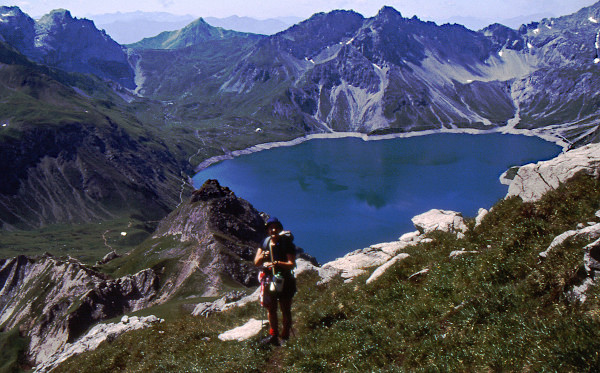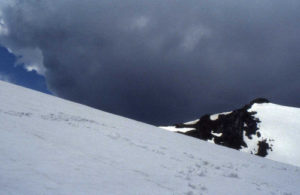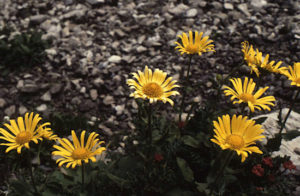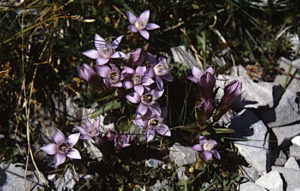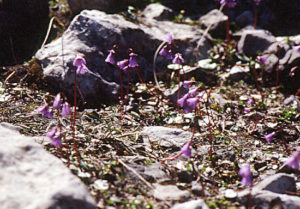Mannheimer Hütte
On a day in early August of 1985 we set out on what turned out to be the most adventurous of our undertakings during the twenty summers in Brand.This would be the most strenuous Wanderung we had ever made. Our hostess and dear friend, Gerti, lent me a pair of red knit gloves, but, as we were to find out, they were not much good for the way the weather turned out on the tricky Südwandsteig.
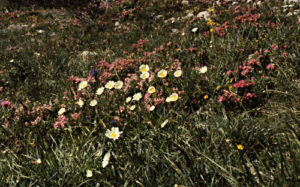
Silberwurz (mountain avens) and Alpenrosen (wild azalea) at the beginning of our ascent to Totalphütte.
We set out from the flowery Lünersee and very soon we got to the kind of mountain hike where no flowers bloomed. If, however, we had turned left (south) to the Totalp after the Totalphütte we would have seen carpets of Silberwurz and other colorful flowers in masses. We will get back to that in the story about Gemslücke.
Mannheimerhütte is at the approximate altitude of 2700 m. and the distance from Douglashütte is a whole lot of kilometers. But of course we spent the night in this very comfortable Hütte. Until this year we had just gone as far as to the Totalphütte, at 2385 m., and we had found that quite enough. But of course this was a two-day trek. Douglashütte is at 2000 m. so it was going to be an ascent of 700 m. in all. We took it all very well though. It is amazing how for each consecutive year your stamina seems to improve. But of course you also get more and more used to the mountains and increasingly trittsicher. (sure of foot)
After Totalphütte, where we rested a bit, we pretty soon got to the Südwandsteig, which is known to be quite hairy. There were cables though all the way and it was actually more fun than it was scary. But it was definitely more for Geübte (trained hikers) than for instance Saulajochsteig. However, the newness of this definitely one-level-up-in-difficulty Steig was exciting and it certainly made the adrenaline flow
We got to the end of this Steig (calling it a path would be a wild exaggeration) and turned right onto the Brandnergletscher. Now came more fun. The dark grey clouds had been gathering in overwhelming masses in the southwest, and pretty soon it began to snow. I will never forget the look of those clouds, and we had already seen them quite clearly on the Südwandsteig. We knew what was to come. It was not really a problem though. We had snow-protection gadgets around the top of our sturdy mountain boots and we felt we were all set for this kind of summer weather. On the way out the snow was not so deep, and we were not yet inside the clouds. We could see clearly ahead of us and follow the poles stuck into the glacier to show the ‘path’. So we walked on in good cheer, and we felt like crying Hurrah when, after passing by the looming bulk of Schesaplana on our right, we saw Mannheimerhütte on the horizon.
We were most likely quite tired though on our arrival at the Hütte, but not so much that I still remember it. We had gone 7.5 km in distance and 700 m in change of altitude, plus the ups and downs, from Douglashütte.
After resting a bit on our beds we went down to the Stube, still feeling chilled into our marrow. Of course the tiredness played a part in our chills too. We ordered Jägertee, tea with rum, one cup after the other, to warm us up — but nothing seemed to help our shivers. John wrote in our Tagebuch that we also had some Obstler, and I don’t doubt it.
We played casino in the Stube with an incomplete deck of cards since all the complete ones were taken. Maybe people brought their own decks of cards. John remembers (or our trip-book does) that we got to know a Dutch couple and one other couple. Not surprising when you are sharing an adventure like this. And all the time it was snowing big white flakes outside the windows.
The Stube was pretty crowded, but most of those people had probably come up via Leibersteig, a narrow ridge on the face of the mountain, which makes for over 1600 meters climb from Brandnertal to Mannheimerhütte. But maybe you can spend the night at Oberzalimhütte. From a picture online it looks as if there are rooms for hikers to spend the night there. I still remember our first year in Brand when we got to Oberzalimhütte, I was awed and incredulous when I saw some mountaineers put their big packs on their backs and set out, clearly going further up, and we had no idea at the time where they were going. We soon learned that you go from Oberzalimhütte to Leibersteig. We know that our friends Fritz abd Renate went to Mannheimerhütte via Leibersteig. But they are a bit of Übermenschen, in my opinion.?
Outside it was snowing very hard now. All night it continued snowing, which we could tell from the amount of snow on the glacier the following morning. And also the snow now went all the way up to the door of the hut, and probably up over the door, even though somone had been out there shoveling the snow away..
On leaving the Hütte after breakfast, we first had to work through all the Bergschuhe that were piled up close to the entrance door. We had walked around in woolen socks in the evening, like everybody else.
It had stopped snowing, but the clouds were all around us. On our way across the glacier we could just barely make out the next pole in front of us from the one we were close to.
On arriving at the Südwandsteig, we realized that we were not at all the only hikers on this ‘path’. One fellow had a backpack that reminded me of Weitwanderer in Lapland, the people who walked into Sarek, spending the light summer nights in sleeping bags in tents — not walking around it, the way we, Mother, Gun and I did in 1950. Some of the people who had arrived the day before via Leibersteig, were clearly now continuing their trekking via Südwandsteig.
We had actually been considering climbing Panülerkopf on this trip, a mountain that is on the right (west) as you leave Mannheimerhütte. I don’t think, however, we would have done it even without this unexpected snowstorm. What we did was wonderful, and it was enough.
Now, the cable on Südwandsteig was a bit of a problem. It was covered in ice, and the knit gloves Gerti had lent me were too slippery for this situation. I had to take them off and grab the icy cable with my bare hands. It felt cold, but I didn’t get stuck to it. It was all right. The same for everyone else, unless they had some slip-free gloves. Leather would most likely have been a lot better.
The Südwandsteig was quite a bit trickier in this icy weather , but we held on firmly to the cables and it was just another fun adventure.
As we got back close to Lünersee we saw the prettiest Zottige Gemswurz, (Doronicum cursii, Austrian leopard’s bane) that we ever saw. I happen to remember that in the southeast corner of Lünersee where we once rested after a long walk, we saw the most gorgeous mass of Zottige Gemswurz. They always made us think of Arnika, but this medicinal flower is quite rare and it always seems to look as if a petal or two are ready to fall off.
After this adventure we began to consider ourselves as seasoned Bergwanderer.. It was our sixth summer in Brand and Haus Kella-Egg and we had learned a lot of flower names, from various kinds of gentians to Alpenrosen and Silberwurz. Just a walk around Lünersee offers you an amazing number of different gorgeous flowers, from a wide variety of bluebells to Alpenrosen and different kinds of violets.
Schesaplana
The following year, in 1986 we felt ready to take on the mighty Schesaplana, approximately 3000 m. and so a change of altitude of 1000 m.from Lünersee. It was exactly September 11 (odd coincidence) and we had been very busy that year with the move from Paris and with our visit to Sachseln and Zermatt, invited by John’s super-generous parents.
We started out early and took the first Bahn up to Lünersee. When we got to Totalphütte there was not a soul at the tables outside. The beginning was like a little piece of Südwandsteig, but we soon turned right and went on up and up. At the outset we did not have the impression that Schesaplana was going to be covered in clouds, but as we kept climbing it got cloudier and cloudier. It did not matter too much though. It was the climb itself that was fun.
We were wearing our Gortex jackets that we had bought the previous year — after the Mannheimer walk — and the funny thing was a man who came down as we were going up. He stopped by me and said “That’s Gortex, right?” I said “Right”, and I chuckled to myself. I was doing my best to put my feet on the right stones, crossing over a small stream, back and forth, as I remember, and here comes a man and asks if my jacket is made of Gortex. Well, the climb was a lot of fun and I was not a bit tense the way I was on Saulakopf in 1981
We gave each other the Gipfelkuss when we got to the cross at the top (Gipfelkreutz), at 2965 m., which is a fun tradition that should be kept alive, and we ate our sandwiches. Well, we also admired the clouds since that was all there was to see. But we had seen so many gorgeous views from mountain tops that we were not really too sad about that. Possibly the best views we had seen were from Südschafgafall and Saulakopf, until we got to know Gemslücke and Geisspitze..
On our way back down, just as we got back onto the path that goes around Lünersee we saw these incredibly wonderful purple gentians (below). The real name is Feld-Kleinenzian.
I always swoon when I see those, for instance at the beginning of Saulajoch. They and the Alpen Troddelblume or Soldanella (below) are my absolute favorites of all the wonderful flowers we have seen up high in the Alps. Down in the shady forests the deep purple Akelei (columbine) is high up on my list of favorite flowers
There are of course some flowers at the lower end of the path to Totalphütte from. Lünersee, but once you get past the hut and turn left onto the Totalp, the stony ground is covered with a different kind of flora, mostly very small flowers. Apart from the various kinds of beautiful moss there are millions of Silberwurz (fjällsippa), Zottige Gemswurz (called ‘yellows’ by us), Alpenrosen, Kleinenzian (the small kind of blue gentians), the deep red moss-like Mannschild growing in carpets among the rocks, tiny bluebells always next to rocks it seems, and the list goes on.
A few days later we drove straight from Brand to Giessen, north of Frankfurt, for Fritz’s and Rebate’s big Fest. I had brought a new dress and high-heeled shoes to Brand, so I was prepared for all the dancing.
In the meantime we had been very busy making our new house in Genas habitable, with closets, cabinets and the like. I don’t think they build unfinished houses like that any more, not even in France, but this was in 1986. In the kitchen there was nothing but a sink,which we exchanged for a resin double sink right away.
______________
In the following years, in the nineties, we extended our walks with our newfound ‘mountain legs’ to Gemslücke and Geißspitze, two quite long hikes which I will write about in the next part of this chapter.
Continued : Chapter 36 (Part 4) – Gemslücke and Geisspitze


